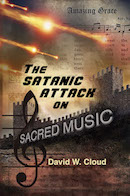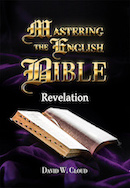866-295-4143, fbns@wayoflife.org

The “normal-literal” method of Bible interpretation refers to the manner in which human language is ordinarily interpreted.
This been called the “golden rule” of Bible interpretation: “When the plain sense of scripture makes common sense, seek no other sense, but take every word at its primary literal meaning unless the facts of the immediate context clearly indicate otherwise” (David Cooper).
“God says what He means and means what He says. We are to read the Bible just as read any other piece of writing, not trying to force some allegorical, mystical, or figurative meaning into its plain statements” (Bible Explorers Guide, John Phillips).
Dr. Charles Feinberg said, “Unless there is some reason intrinsic within the text itself which requires a symbolical interpretation or unless there are other Scriptures which interpret a parallel prophecy in a symbolic sense, we are required to employ a natural, literal interpretation” (Premillennialism or Amillennialism?, p. 212).
We use figures of speech, such as metaphors, in normal speech, but we understand that these are figures of speech by the context and we know how to interpret them. If I say, “I’m going for a run,” we know that this means that I am literally going to go running. But if I say, “I’m going to run down to the store,” we know this is a figure of speech, and it simply means that I am going to the store, whether by walking, driving, etc.
The same is true for Bible prophecy. It contains figures of speech, but the Bible makes it clear that these are figures of speech and teaches us how to interpret them either by the context itself or by comparing Scripture with Scripture.
Contrast the allegorical method of interpretation
The allegorical method interprets the prophetic portions of Scripture in a symbolic manner rather than a literal one. By this method, the Old Testament prophecies of Israel’s glorious earthly kingdom are interpreted as descriptions of the church age. So “Sion” is the church and “the thousand years” of Revelation 20 are the church age and the desert blossoming as the rose (Isa. 35:1) is fruitfulness in the church age.
Consider three examples:
The Geneva Bible note at Revelation 9:11 identifies “the Angel of the bottomless pit” as “Antichrist the Pope, king of hypocrites and Satan’s ambassador.” There is no reason, though, to see this angel as anything other than a literal fallen angel in a literal bottomless pit.
Adam Clarke on Revelation 20:2: “In what this binding of Satan consists, who can tell? ... it is not likely that the number, a thousand years, is to be taken literally here.”
Jamieson, Fausset, Brown on Revelation 20:2: “Thousand symbolizes that the world is perfectly leavened and pervaded by the divine; since thousand is ten, the number of the world, raised to the third power, three being the number of God.”
The history of allegoricalism
The early Christians interpreted prophecy literally (Ac. 3:19-21; Ro. 11:25-27). This is admitted by most church historians.
Lutheran historian Adolph Harnack wrote, “Faith in the nearness of Christ’s Second Advent and the establishing of His reign of glory on the earth was undoubtedly a strong point in the primitive Christian church” (“Millennium,” Encyclopedia Brittanica).
Consider again the statement by the Lutheran historian Philip Schaff: “The most striking point in the eschatology of the ante-Nicene age [before 325 AD] is the prominent chiliasm, or millenarianism, that is the belief of a visible reign of Christ in glory on earth with the risen saints for a thousand years, before the general resurrection and judgment. ... It was indeed ... a widely current opinion of distinguished teachers, such as Barnabas [end of first century], Papias [a disciple of John], Justin Martyr [born about 100 AD], Irenaeus [120-202 AD] the disciple of Polycarp who in turn was the disciple of John, Tertullian [150-220 AD], Methodius [third century], and Lactantius [end of third and beginning of fourth century]” (History of the Christian Church, 1884, II, p. 614).
G. A. Simcox, who interprets Revelation allegorically, admits that “from the time of Tertullian and Hippolytus--not to say Justin and Irenaeus--we have a consistent expectation of the course of events that will precede the last judgment” (Simcox, The Revelation of St. John the Divine).
Amillennialist Louis Berkhof says, “During the early Christian centuries the prevailing, though not officially recognized view of the Kingdom of God was eschatological [future], and in some cases Chiliastic [millennial]” (The Kingdom of God, p. 21).
Greek scholar and Bible commentator Dean Alford says, “I cannot consent to distort words from their plain sense and chronological place in the prophecy on account of any risk of abuses which the doctrine of the Millennium may bring with it. Those who lived next to the Apostles, and the whole Church for 300 years, understood them in the plain literal sense and it is a strange sight in these days to see expositors who are among the first in reverence for antiquity, complacently casting aside the most cogent instance of consensus which primitive antiquity presents. As regards the text itself, no legitimate treatment of it will extort what is known as the spiritual interpretation now in fashion” (The Greek Testament, IV, p. 732, cited from Chester Tulga, Premillennial or Amillennial: An Introductory Study).
Dr. John Walvoord says, “[T]here are clear and unmistakable evidences of Premillennialism in the first century. In contrast to these clear evidences, there is not one adherent, not one live of evidence is produced sustaining the idea that any first century Christians held Augustinian Amillennialism. Furthermore, there is no evidence whatever that Premillennialism was even disputed. It was the overwhelming view of the early Church” (The Millennial Kingdom, p. 119).
George Ladd says, “A survey of the literature leads to the following conclusions. The understanding of the Kingdom is exclusively eschatological [literal kingdom of the future] and with one exception there is no church father before Origin who opposed the Millenarian interpretation, and there is no one before Augustine whose extant writings offer a different interpretation of Revelation 20 than that of a future earthly Kingdom consonant with the natural interpretation of the language” (Crucial Questions about the Kingdom of God, p.23)
The churches in Asia Minor, which were the first churches established by the apostle Paul and his co-workers, held to a literal interpretation of prophecy for centuries. Amillennialist T. Francis Glasson says, “In the early centuries, it was largely on account of the book of Revelation that Millenarianism flourished in some quarters. ... Years ago Neander, the great church historian, pointed out that ‘Wherever we meet with Chiliasm, in Papias, Irenaeus, Justin Martyr, everything goes to indicate that it was diffused from one country and from a single fountainhead’” (His Appearing and Kingdom, p.122). That “fountainhead” is the very place where the book of Revelation was written and where the churches were located to which it was written, and where where many of the other New Testament epistles were written. Amillennialist theologians Glasson and Neander are saying that these churches interpreted Revelation and the apostolic prophecies literally and this remained the fountainhead of literal interpretation until it was destroyed by apostasy in the fourth and fifth centuries. Papias was the pastor of the church at Hierapolis, near Laodicea. Justin Martyr lived at Ephesus. Iranaeus spent the early years of his Christian life in that region.
The allegorical interpretation was invented by false teachers after the time of the apostles.
A school was established at Alexandria, Egypt, which became the headquarters for the allegorical method of interpretation. Egypt was a place where false teaching proliferated in the early centuries after Christ.
Clement headed the school from 190 to 202. He corrupted the Christian faith by mixing it with the worldly philosophy of Plato. He taught many false doctrines, including purgatory, and believed that most men would eventually be saved even though Jesus said only a few would be (Mt. 7:14).
Origen (A.D. 185-254) was one of the chief fathers of allegoricalism. Louis Berkhof says, “Through the combined influence of Origin and Augustine, and of the Christianizing of the empire in the time of Constantine the Great, the Chiliastic [literal millennial] view of the Kingdom was gradually eclipsed by the representation of the Kingdom as a present reality” (The Kingdom of God, p.113). Origen said, “The Scriptures have little use to those who understand them literally.” He described the literal meaning of Scripture as “bread” and encouraged the student to go beyond this to the “wine” of allegoricalism, whereby one can become intoxicated and transported to heavenly realms. Origen’s commentaries contained a mass of fanciful interpretations, abounding in “heretical revisals of Scripture” (Frederick Nolan, Inquiry into the Integrity of the Greek Vulgate, p. 367). Origen led the school at Alexandria from 202 to 232. Though he endured persecution and torture for the cause of Christ under the emperor Decius in 250, Origen held many false teachings. Like Clement, he mixed the truth of the Bible with pagan philosophy. Following are some of his heresies: He taught baptismal regeneration, purgatory, the pre-existence of the human soul, and universalism (with even the devil eventually being saved). He taught that the Holy Spirit was the first creature made by God and denied that Jesus is fully God. He did not believe that the Scriptures are wholly inspired by God. He taught that celibacy is a holy state above marriage.
Augustine was so influential in changing the literal interpretation of prophecy to the allegorical that he has been called “the father of amillennialism.” Yet he testified that there were many in his day [fifth century BC] who believed in a literal millennium. He said, “I myself, too, once held this opinion. ... They who do believe them are called by the spiritual, Chiliasts, which we may literally reproduce by the name Millenarians” (Augustine, City of God, book 20, chapter 7). Amillennialist Oswald T. Allis says, “The view which has been most widely held by opponents of Millenarianism is associated historically with the name of Augustine. He taught that the Millennium is to be interpreted spiritually as fulfilled in the Christian Church. He held that the binding of Satan took place during the earthly ministry of our Lord (Luke 10:18), that the first resurrection is the new birth of the believer (John 5:25), and that the Millennium must correspond, therefore, to the interadventual period or church age. This involved the interpreting of Rev. 20:1-6 as a ‘recapitulation’ of the preceding chapters instead of as describing a new age following chronologically on the events set forth in chapter 19” (Prophecy and the Church, pp.2-3).
The Roman Catholic Church interpreted Bible prophecy allegorically throughout its history.
The Protestant denominations (e.g., Anglican, Presbyterian, Lutheran, Methodist) have also interpreted prophecy allegorically, with few exceptions. This is one of the errors they brought out of Rome.
Why we interpret the prophecies literally
First, God gave the Scriptures to REVEAL truth to man, not to hide it. See Deuteronomy 29:29. Prophecy is given to reveal secrets, not hide them. Prophecy is light, not darkness (2 Pe.1:19). The Bible’s final book of prophecy, Revelation, is so named because it is given to reveal truth, not hide it. Prophecy is to be understood in the normal way that human language is understood because it is God’s revelation to mankind in human language. God made human language, and He has communicated His revelation to man in normal human language that is interpreted in a normal way that language is interpreted.
Second, the apostles interpreted prophecy literally.
Consider two key passages:
Acts 3:18-21 - Peter preached that as there was a literal fulfillment of Christ’s first coming to suffer for man’s sin, so there will be a literal fulfillment of the prophecies pertaining to Israel’s conversion and kingdom. The heaven will receive Christ until He returns. Then there will be a “restitution of all things, which God hath spoken by the mouth of all his holy prophets.” Words could not be plainer. The prophecies of Israel’s regathering and conversion and blessing and the prophecies of Christ sitting on David’s throne will be literally fulfilled.
Romans 11:25-27 - Paul also taught that God’s covenants with Israel will be literally fulfilled. Israel is currently blind, except for those few, like Peter and Paul, who are saved. Israel will be blind only until the fulness of the Gentiles is come in, referring to the church age. Then Israel will be saved and her covenants fulfilled. Again, words could not be plainer.
That the apostles and the apostolic churches interpreted prophecy literally is admitted by most church historians, as we have seen.
Even Augustine, “the father of amillennialism,” admitted that there were many in his day [fifth century] who believed in a literal fulfillment of Revelation 20. He said, “I myself, too, once held this opinion. ... They who do believe them are called by the spiritual, Chiliasts, which we may literally reproduce by the name Millenarians” (Augustine, City of God, book 20, chapter 7).
The church at Antioch continued to interpret prophecy literally after the allegorical method was invented by heretics such as Origen (185-254). Antioch, of course, was an important church founded by Barnabas and Paul, and it is from this church that the first foreign missionaries were sent out (Acts 11:19-26; 13:1-4; 15:39-41). It was at Antioch that the disciples were first called Christians. Some of the preachers associated with Antioch were Lucian (died 312), Diodorus of Tarsus (d. 390), Chrysostom (d. 407), Theodore (d. 428), and Theodoret (d. 458). These men did not accept the Alexandrian allegorical method of interpretation. They interpreted Bible prophecy literally. Farrar says, “Diodorus of Tarsus’ books were devoted to an exposition of Scripture in its literal sense, and he wrote a treatise, now unhappily lost, ‘on the difference between allegory and spiritual insight’” (F. W. Farrar, History of Interpretation, pp. 213-15).
Third, Bible prophecies have always been fulfilled literally.
Prophecies about Israel were fulfilled literally.
Israel’s entire history was given in the great prophecy of Deuteronomy 28 (see particularly verses 63-67). This prophecy describes Israel’s defeat at the hands of foreign powers and her dispersion to the ends of the earth, and they have been fulfilled literally and precisely over the past 2,000 years, beginning with the Babylonian Captivity and then Rome’s destruction of Jerusalem in AD 70 and again in AD 135.
Prophecies of the nations were fulfilled literally.
The prophecies of the nations by Isaiah, Ezekiel, and Daniel were so precise that scoffers have said that they must have been written after the events.
TYRE
Consider the prophecy of the ancient city of Tyre in Ezekiel 26:3-16. Tyre was the capital of the great Phoenician Empire. The city consisted of two parts. One part of the city was on the coast and another part was on an island about a half mile off the coast. It was one of the most beautiful cities of ancient times.
- Nebuchadnezzar will besiege and sack Tyre (Eze. 26:7-11). In 573 BC, Nebuchadnezzar conquered Tyre after a 13-year siege. At that time the coastal city was destroyed, but the city on the island was not conquered.
- Many nations will participate in destroying Tyre (Eze. 26:3). Tyre was attacked and overcome by the Assyrians, the Babylonians, the Greeks, the Syrians, the Romans, and finally the Muslims.
- Tyre’s walls and towers will be destroyed (Eze. 26:4). This was done first by Nebuchadnezzar and then by Alexander the Great.
- The city will be made flat like the top of a rock and even the dust will be scraped (v. 4), and its stones and timbers will be laid in the sea (Eze. 26:12). This was done in 332 BC when Alexander used the material from the ruins of the city on the coast to build a land bridge out to the island.
- Tyre will become a place for the spreading of nets (Eze. 26:5, 14). The great mart of the nations eventually became a lowly fishing village.
- Tyre was a spoil to the nations (Eze. 26:12). After her destruction by Alexander, Tyre did not regain her position as the head of an empire; instead, she was the vassal of whatever power happened to dominate the region.
Prophecies of Christ’s first coming were fulfilled literally.
Consider the prophecy of Christ’s first coming in Psalm 22. In this Psalm alone, there are many specific prophecies about Christ’s death, and they were literally fulfilled:
Psa. 22:1 – Jesus’ words on the cross (Mt. 27:46)
Psa. 22:6-8, 12-13 – The people reviled Jesus (Mt. 27:39-44)
Psa. 22:11 – There were none to help Him (Mk. 14:50; Heb. 1:3)
Psa. 22:14-16 – They crucified Him (Mt. 27:35)
Psa. 22:14-15 - Christ’s thirst from blood loss (Joh. 19:28)
Psa. 22:17a – They did not break his bones (Joh. 19:33)
Psa. 22:17b – They stared at Him (Mt. 27:36)
Psa. 22:18 – They gambled for his garments (Mt. 27:35; Joh. 19:24)
Since Bible prophecy has always been fulfilled literally, there is no reason to believe that future prophecies will be fulfilled any differently.
Fourth, the Lord Jesus said the major prophetic events are yet future.
In His prophecy in Matthew 24, He described the Great Tribulation and the rule of the Antichrist and said that these events will occur in the future just prior to His literal return (Mt. 24:15-29). It is obvious, then, that the Great Tribulation is not something that has already been fulfilled in history or is being fulfilled, and it is obvious that the Antichrist is a literal man who will desecrate a literal third temple.
Fifth, Christ rebuked His disciples for not believing the prophecies in their literal interpretation (Lu. 24:25-27).
Sixth, the stage is set today for the literal fulfillment of the prophecies.
Everything is ready. The machinery for a one-world government and a one-world religion as described in Revelation 13 and 17 is being set up before our eyes. The technology is in place to control the world’s commerce as described in Revelation 13:16-17 and for the people of the world to observe the events described in Revelation 11:8-10. Most importantly, the nation Israel is back in her land in fulfillment of Ezekiel 37:1-14 (Ezekiel said she would return first in a spiritually-dead condition, verse 8) and in preparation for the literal fulfillment of the rest of her prophecies. She is making preparations to build the third temple, which will be desecrated by the Antichrist. She is looking for a peace-making, temple-building Messiah, which is exactly what the Antichrist will be at the beginning of his reign when he makes a seven-year covenant with Israel as per Daniel 9:27. This supports the doctrine that God has not rejected the nation Israel in a permanent sense or replaced Israel with the Church, but has only temporarily set Israel aside until He is ready to fulfill His covenants with her. This is clearly taught in Romans 11:25-29.
Seventh, practical necessity demands the literal interpretation of prophecy.
To interpret Bible prophecy allegorically destroys the absolute sense of God’s Word. It ceases to be a “sure word” (2 Pe. 1:19). If prophecy does not mean exactly what it says, there is no way to know what it does mean. Consider Revelation 20:1-3. If this passage does not mean that a literal angel binds a literal devil in a literal bottomless pit for a literal thousand years, we have no way of knowing for sure what it does mean. If it does not mean what it literally says, it could mean anything that any interpreter says it means.
Consider this important statement by Paul Lee Tan: “Whether it is the interpretation of prophecy or non-prophecy, once literality is sacrificed, it is like starting down an incline. Momentum speedily gathers as one succumbs to the temptation to spiritualize one passage after another. ... Moreover, under the method of spiritualization, there is no way for an interpreter to test the validity of his conclusions, except to compare his works with that of a colleague. Instead of ‘a more sure word of prophecy’ (2 Pe. 1:19), interpreters end up with an ‘unsure’ word and chaos in the ranks” (Tan, The Interpretation of Prophecy, pp. 73, 74).
Bible teacher Vernon McGee was trained in the allegorical method of interpretation, but he realized as a young man that it resulted in foolishness: “I went to a seminary that was amillennial, where they attempted to fit the rest of Revelation into the historical, or the amillennial, viewpoint. It became ridiculous and even comical at times. For example, when we reached the place where Scripture says that Satan was put into the bottomless pit, we were taught that that has already taken place. I asked the professor, ‘How do you explain the satanic activity that is taking place today?’ He replied, ‘Satan is chained, but he has a long chain on him. It is like when you take a cow out into a vacant lot and tether her out on a long rope and let her graze.’ That was his explanation! And my comment was, ‘Doctor, I think Satan’s got a pretty long chain on him then, because he is able to graze all over the world today!’ It really makes some Scriptures seem rather ridiculous when you follow the allegorical viewpoint” (Thru the Bible with J. Vernon McGee).
It is for failure to apply the literal method that the book of Revelation has been so puzzling to Catholic and Protestant commentators. “On the whole no one in the later Middle Ages did more than think of it as a puzzling moral allegory. Luther at first dismissed it; Calvin declined to comment on it. Erasmus’s position was of doubting its authenticity. Acts and Revelation are the only books in Tyndale’s 1534 New Testament without prologues ... his marginal notes to Revelation are so minimal as effectively not to exist” (David Daniell, The Bible in English, p. 348).
Eighth, prophecy as an apologetic demands a literal interpretation.
In Isaiah, Jehovah God Himself uses Bible prophecy as evidence that He is its Author. See Isaiah 41:22-23; 44:6-7; 45:21-22; 46:9-10. The reason that Bible prophecy can be used as an evidence of the divine inspiration of Scripture is that it is precise and clear. Charles Feinburg, who had a Ph.D. in Archaeology and Semitic Languages from Johns Hopkins University, observed, “Although the intellectual atmosphere of our times is against it, this literal fulfillment of Biblical prophecy remains to an open mind a strong apologetic for the supernatural character of the Scriptures” (Premillennialism or Amillennialism?, p. 212). Bible prophecy contains details such as names, dates, and places.
For example, Psalm 22 contains the details of Christ’s death, as we have seen. David wrote this 1,000 years before Christ. It is impossible for man to know such things about the future. For such details about a man’s life to be written in a book hundreds of years before his birth is irrefutable evidence that that book is of God. But if the details of the prophecies are not interpreted literally, the prophecies cannot be used as an apologetic because it will not be clear exactly what is being prophesied. If piercing of the hands and feet, for example, means something other than a literal piercing then the power of the prophecy as an apologetic is destroyed.
Consider the prophecy of Israel that was given in Deuteronomy 28 before they even entered Canaan: Israel’s land would be devoured by foreigners (v. 33); Israel’s cities would be besieged and destroyed by a nation of fierce countenance (vv. 50-57); Israel will be scattered among the nations and find no rest or safety (vv. 64-67); Israel would become an astonishment, a proverb, and a byword among all nations (v. 37). This is so precise that it is like reading an outline of Israel’s history over the past 2,500 years. Deuteronomy 28 proves that the Pentateuch is divinely inspired and not a product of human redaction as modernists, and even many evangelicals, claim. It gives the details of events in Israel’s history that occurred after the time when the modernists claim the book was written (in the kingdom era). It describes the destruction of Jerusalem by the Babylonians (6th century BC) and Romans (1st century AD) and the worldwide dispersal of the Jews and their terrible condition over last two millennia. That plainly means that Deuteronomy is a supernatural, divinely-inspired book just as Jesus taught.
- Receive these reports by email
- www.wayoflife.org
______________________
Sharing Policy: Much of our material is available for free, such as the hundreds of articles at the Way of Life web site. Other items we sell to help fund our expensive literature and foreign church planting ministries. Way of Life's content falls into two categories: sharable and non-sharable. Things that we encourage you to share include the audio sermons, O Timothy magazine, FBIS articles, and the free eVideos and free eBooks. You are welcome to make copies of these at your own expense and share them with friends and family. You may also post parts of reports and/or entire reports to websites, blogs, etc as long as you give proper credit (citation). A link to the original report is very much appreciated as the reports are frequently updated and/or expanded. Things we do not want copied and distributed are "Store" items like the Fundamental Baptist Digital Library, print editions of our books, electronic editions of the books that we sell, the videos that we sell, etc. The items have taken years to produce at enormous expense in time and money, and we use the income from sales to help fund the ministry. We trust that your Christian honesty will preserve the integrity of this policy. "For the scripture saith, Thou shalt not muzzle the ox that treadeth out the corn. And, The labourer is worthy of his reward" (1 Timothy 5:18). Questions? support@wayoflife.org
Goal:Distributed by Way of Life Literature Inc., the Fundamental Baptist Information Service is an e-mail posting for Bible-believing Christians. Established in 1974, Way of Life Literature is a fundamental Baptist preaching and publishing ministry based in Bethel Baptist Church, London, Ontario, of which Wilbert Unger is the founding Pastor. Brother Cloud lives in South Asia where he has been a church planting missionary since 1979. Our primary goal with the FBIS is to provide material to assist preachers in the edification and protection of the churches.
Offering: Offerings are welcome if you care to make one. If you have been helped and/or blessed by our material offerings can be mailed or made online with with Visa, Mastercard, Discover, or Paypal. For information see: www.wayoflife.org/about/makeanoffering.html.





